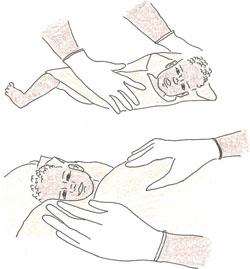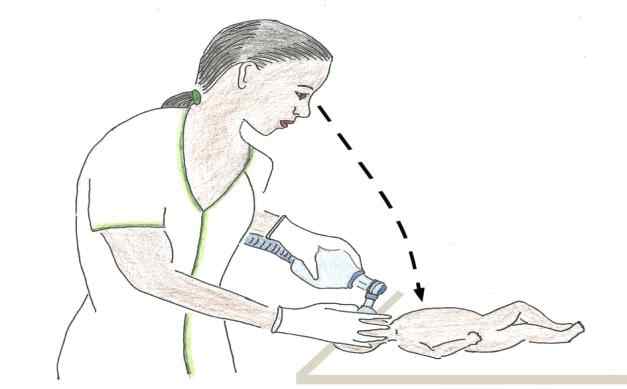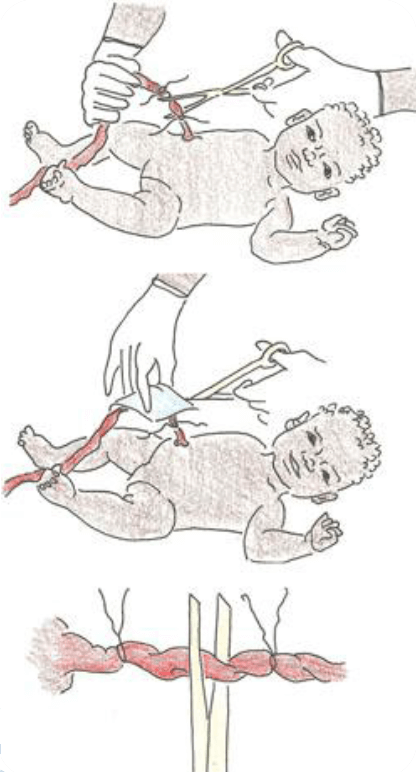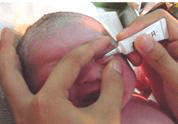Most babies breathe and cry at birth with no help. Remember that the baby has just come from the mother‘s uterus. It was warm and quiet in the uterus, and the amniotic fluid and walls of the uterus gently touched the baby. You too should be gentle with the baby and keep the baby warm. Skin-to-skin contact with the mother keeps baby at the perfect temperature.
The following are the steps of immediate newborn care which should be given to all babies at birth.
Step 1. Deliver baby onto mother’s abdomen or a warm, dry surface close to the mother: to keep the baby warmth and prevent heat loss
Step 2. Drying the newborn: this is to dry the baby, first, dry the baby with a dry towel then cover another towel on his body including the head (Figure 7.1).

Figure 7.1. Drying and wrapping the newborn baby.
Step 3. Assess breathing and colour
- Asses the skin colour of the newborn if it is pink and the apical heart beat (AHB) is > 100 beats/minute. If not breathing well, < 30 breaths/minute, stop steps of essential newborn care. Clamp and cut the cord quickly then start resuscitation:
- Put the baby in back position with the neck slightly extended to open the airway (Figure 7.2).
- Removing mucus and secretions.
- Initiate ventilation with the Ambu bag while you are positioned at the head of the baby and you should look fetal chest movement with each ventilation.

Figure 7.2. Positioning and looking at the chest movement while ventilating.
- Make sure that the mask fit wells and covers the mouth, nose and chin and no air escape between the mask and the newborn face. Do not force the mask to newborn face as this will cause downward movement of the chin toward the chest and compress the airway.
- Now check the AHB of the newborn. If the AHB is less than 60 beats / minute; then, It is essential to provide a heart massage with ventilation alternatively (on and off ventilation).
- You should never attempt to do a heart massage, as this could damage the sternum or rib bones of the newborn.
Step 4. Tie the cord and cut the cord
i) Tie the cord securely in two places:- Make sure that the thread you use is clean and safe.
- Do the first tie, two fingers away from the baby‘s abdomen.
- Do a second tie, four fingers away from the baby‘s abdomen.
- Make sure that the ties are well secured.
- Make sure that the thread you use is clean and safe.
ii) Cut the cord between both ties:
- Use a new razor blade, or a boiled one if it has been used before, or sterile scissors.
- Use a small piece of cloth or gauze to cover the part of the cord you are cutting so no blood splashes on you or others.
- Be careful not to cut or injure the baby. Either cut away from the baby or place your hand between the cutting instrument and the baby.
iii) Do not put anything on the cord stump
- Oobserve for oozing blood. If blood is oozing, place a second tie between the skin and the first tie.

Fig. 7.3. Tying and cutting the cord.
Step 5. Place the baby in skin-to-skin contact and on the breast to initiate breastfeeding.
The warmth of the mother passes easily to the baby and helps stabilise the baby‘s temperature.
- Put the baby on the mother‘s chest, between the breasts, for skin-to-skin warmth
- Cover both mother and baby together with a warm cloth or blanket
- Cover the baby‘s head.
The first skin-to-skin contact should be done uninterrupted for at least 1 hour after birth or until after the first breastfeed.
The baby should not be bathed at birth because the bath can cool him dangerously. After 24 hours, he can have the first sponge bath, if his temperature is stabilised. If everything is normal, immediately start breastfeeding and continue doing the following recommendation for optimal breastfeeding:
- Help the mother begin breastfeeding within the first hour of birth.
- Help the mother at the first feed. Make sure the baby has a good position, attachment, and suck. Do not limit the time the baby feeds; early and unlimited breastfeeding gives the newborn energy to stay warm, nutrition to grow, and antibodies to fight infection.
Step 6. Give eye care.
Shortly after breastfeeding and within one hour of age, give the newborn eye care with a TTC ointment. Eye care protects the baby from serious eye infection that can result in blindness.
Steps for giving eye care (Figure 7.4):
- Wash your hands.
- Tetracycline 1% eye ointment.
- Hold one eye open and apply a rice grain size of ointment along the inside of the lower eyelid. Make sure not to let the medicine drop or the tube touch the baby‘s eye.
- Repeat this procedure with the other eye.
- Do not rinse out the eye medication.

Fig. 7.4. Applying tetracycline eye ointment into the eyes of the newborn baby.
Step 7. Give Vitamin K.
- Administer Vitamin K 1mg IM on the anterior lateral thigh while he/she held by his mother i.e. to prevent spontaneous bleeding.
Step 8. Weigh the newborn.
- Weigh the baby one hour after delivery and refer urgently if VLBW to the health centre or hospital.
- Low birth weight (LBW): neonate with a birth weight less than 2.5 kg.
- Very low birth weight (VLBW): neonate with a birth weight less than 1.5 kg.
Step 9. Identification.
Step10. Record your findings.




